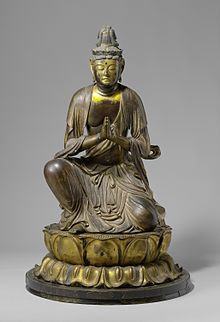Gasshō

Gasshō ( Japanese 合掌 ) describes a basic greeting gesture ( mudra ) in Japanese Buddhism .
Word meaning
Gasshō literally means “palms joined together” and is the Japanese translation of the Sanskrit term añjali [mudrā] , which in turn is the gesture from the Indian greeting Namaste , which can also be found in other countries, e.g. B. as Wai in Thailand or Sampeah in Cambodia .
execution
The palms of the hands are brought together in front of the chest. The fingers are parallel, straight and touching. The fingertips point upwards. After looking at the fingertips, there is a slight incline, with a maximum of 45 °.
meaning
The gesture has a double symbolism. On the one hand, in India the right hand is the clean one and the left the dirty one, so that the joining together suggests a dissolution of the opposites. On the other hand, in Buddhism, the right hand stands for Buddha himself and the left for all living beings, so that by touching them both are united with one another and thus indicates the entry into nirvana .
Gasshō is used in zen when entering the zendō (zen hall), before zazen and, depending on the zen line, also during other rituals and also signals respect for the exercise.
In the Edo period , an architectural style ( zukuri ) developed in the Shirakawa and Gokayama region , which is characterized by very steep roofs and is referred to as gasshō-zukuri ( 合掌 造 ) after the gesture . In sumō there is a technique called gasshō-hineri ( 合掌 捻 り ).
Web links
- Gassho on buddhaweg.de